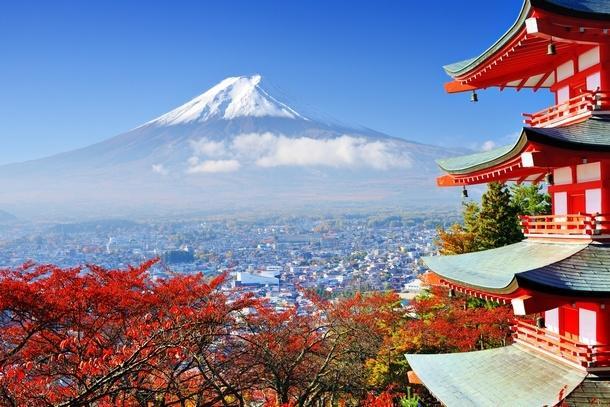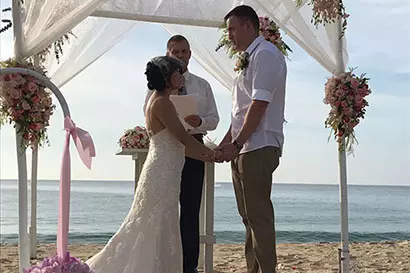Ad
Destination weddings in Japan - Japanese Wedding Guide

Japan is the perfect wedding destination for couples who are looking for something completely different. There’s truly nowhere else in the world that manages to seamlessly blend the elegant and the weird, the traditional and the futuristic. With exceptional cuisine, fascinating architecture, and diverse natural scenery, it’s virtually impossible not to be drawn in by Japan’s beguiling culture.
Get married in the simple, yet beautiful setting of a Shinto shrine, while wearing an exquisite traditional kimono. Exchange your vows under delicate cherry blossoms, or against the backdrop of colorful autumn leaves.
With hundreds of hot spring resorts and even tropical beaches, you might even find you want to stay in Japan for your honeymoon.
| Fact File | Highlights |
| Weather & Climate | Culture & Etiquette |
| Food & Drink | Money & Wedding Costs |
| Legal Requirements | Prefectures. Destination weddings in Japan |
| Wedding Providers Japan |
Fact File
- Size: 377,944 km²
- Population: 125.8 million (2022)
- Capital City: Tokyo
- Currency: Japanese Yen (JPY)
- Language Spoken: Japanese
- Main Religions: Shinto, Buddhism
- Major Holidays:
- New Year's Day - January 1
- Coming of Age Day - January 14
- National Foundation Day - February 11
- Spring Equinox - March 20
- Shōwa Day - April 29
- Constitution Memorial Day - May 3
- Greenery Day - May 4
- Children's Day - May 5
- Children's Day (observed) - May 6
- Sea Day - July 15
- Respect for the Aged Day - September 16
- Autumn Equinox - September 23
- Sports Day - October 14
- Culture Day - November 3
- Culture Day (observed) - November 4
- Labor Thanksgiving Day - November 23
- Emperor's Birthday - December 23
- Major Festivals - Each city and town in Japan celebrate at least one festival per year. Some of the larger festivals include:
- Sapporo Yuki Matsuri, Sapporo - February
- Kamakura Festival, Akita Prefecture - February 15-16
- Omizutori, Nara - March 1-14
- Takayama Matsuri, Hida-Takayama - April and October
- Sanja Matsuri, Tokyo - May
- Kyoto Gion Matsuri, Kyoto - July
- Tenjin Matsuri, Osaka - July 24-25
- Nebuta Matsuri, Aomori - August 2-7
- Kanto Matsuri, Akita - August 3-6
- Nagasaki Kunchi, Nagasaki - October 7-9
- Jidai Matsuri, Kyoto - October 22
Highlights
Tokyo and Kyoto are easily the most popular tourist destinations in Japan. Tokyo gives visitors a glimpse into Japan’s eclectic, futuristic present, while Kyoto’s temples and shrines are a portal into the traditions and culture of Japan’s past.

Tokyo is the perfect place to see a live performance like kabuki or taiko drumming, or even a sporting event such as sumo wrestling or Japanese baseball. In Kyoto, try staying overnight in a temple, or in a traditional Japanese inn, called a ryokan.
From Tokyo, it’s easy to make a day trip to see the stunning shrines in Nikko, or the infamous Mt. Fuji. Kyoto can be the gateway to the deer-filled park in Nara or the foodie city of Osaka.
Once you venture away from these tourist hubs, it’s easy to get off the beaten path in Japan. Hikers and climbers can venture north to the sweeping national parks in Hokkaido or the mountainous Japanese Alps in Central Honshu. Central Honshu is also home to centuries-old architecture, as well as dozens of natural hot springs. Japan also has countless islands waiting to be explored. Check out the contemporary art galleries on Naoshima, or the tropical beaches in Okinawa.
Weather and Climate

Japan’s weather is generally quite mild, although temperatures can vary significantly across this lengthy country. Its northernmost prefecture, Hokkaido, has temperatures ranging from frosty lows of -12°C in the winter, to pleasant highs of 22°C in the summer. Yet, if you journey south to Japan’s opposite end, you’ll find Okinawa, where temperatures rarely drop below 20°C throughout the entire year.
Spring (March-May) and autumn (September-November) are the best times of year to visit Japan. In the spring, temperatures are pleasantly warm, rainfall is minimal and, best of all, Japan’s famous cherry blossoms are in bloom. In autumn, the stunning red and gold leaf colors attract almost as much attention as the cherry blossoms in the spring. The cool temperatures and gorgeous foliage make autumn a lovely season to visit, provided that you avoid typhoon season from August to October.
Summer and winter can also be enjoyable, as long as you’re prepared for slightly more extreme weather conditions. Summer, which begins in June, brings humid weather, as well as a rainy season that lasts until mid-July. Winters are mild in Southern Japan, but quite cold in the North, with regular snowfall in the Central and Northern prefectures. Despite the cold, the weather is often sunny, so winter is the best time for skiers and other winter sports enthusiasts to visit.
Culture and Etiquette
It could take years to understand the complex subtleties of Japanese social etiquette and, as a tourist, it’s almost impossible to avoid becoming a bull in the china shop that is Japanese culture. Fortunately, Japanese people are generally very forgiving of tourists’ social faux pas, but it’s still a good idea to keep a few basic courtesies in mind.
Japanese people usually bow to greet one another, express thanks, apologize, or request a favor. Bows typically range in depth based on the situation and the social hierarchy of the people involved. If you’re not sure what to do, a small nod of your head is a good way to show politeness without overdoing it.
When entering a house, Japanese-style hotel, and some restaurants, outdoor shoes are removed and slippers are worn instead. If you see a cluster of shoes around the doorway, it’s a good indicator that you’re expected to take your shoes off before entering.
You can generally dress in Japan the same way you would at home. However, Japanese people, particularly in big cities, are almost always immaculately groomed and well-dressed. Consider saving your ripped sweatpants and dirty sneakers for your hotel room, unless you want to come across as sloppy. Women should also avoid low-cut or sheer shirts, which are much less socially acceptable in Japan than they are in the West.
There are very few public garbage cans in Japan, which is partly because Japanese people don’t scarf down bagels and coffees while walking to work. It’s considered rude to walk while eating or drinking, so they don’t really accumulate garbage on the go.
Japanese people are not generally very touchy, so it’s best to limit public displays of affection to hand-holding at most. You might see some Japanese teens kissing or hugging in public, but this can be offensive, especially for older Japanese people. When you’re in public, it’s also important to pay attention to the volume of your voice, particularly on trains and buses. You’ll notice that Japanese people generally speak quietly, so try not to be too loud.
Food & Drink
When people think of Japanese cuisine, sushi is typically the first food that comes to mind. Yet, sushi is only the beginning of the diverse and delicious dishes that make up Japanese cuisine. Rice, miso soup, tofu, and pickled vegetables are some of the basic components, but the variety of dishes is almost endless: yakitori skewers, thick curry rice, shabu-shabu soup, and all of the types of different noodles. There are also dozens of regional specialties, like savory okonomiyaki in Osaka, or momijimanju cakes in Hiroshima.
The best approach is to be willing to try absolutely everything, even if you’re not entirely sure what it is. Many restaurant windows display plastic or wax models of their dishes, which can be a great way to get an idea of what you’ll be ordering. You can also try asking your server “osusume wa nanidesu ka?” which means “what do you recommend?”
Expect to be greeted with a startlingly enthusiastic “irasshaimase” (welcome) when you enter a restaurant. When you sit down, you’ll usually be given a small, wet towel called an oshibori to use for washing your hands.
Chopsticks are the most important component of Japanese dining etiquette. Never wave or point your chopsticks, and don’t stick them in your food. You’ll often find a small chopstick rest, called a hashioki, at your table, where you can place your chopsticks when you’re not eating. If the restaurant has wooden chopsticks, you can fold the paper cover into a hashioki.
Most restaurants serve complimentary green tea or water with meals. If you want something a little stronger, try sake or shochu. Sake, or nihonshu, is an alcoholic beverage made from fermented rice that can be served either hot or cold. Shochu is a distilled alcoholic drink, made from rice, wheat, sweet potato, or barley. If you’re dining with a group, it’s polite to keep each other’s glasses filled, rather than pouring your own.
In some restaurants, like izakaya (Japanese pubs), a group normally orders a few small dishes to share. In other restaurants, each diner orders a meal individually. If you’re sharing food, remember not to use the end of the chopstick that has been in your mouth to pick up food from shared dishes.
Paying at the table is not common, so just bring your bill up to the cashier when you’re finished. An increasing number of restaurants accept credit cards, but it’s best to check first or carry extra cash because cash is still the most common method of payment. There’s no need to tip – in fact, you’ll probably be offered your “change” if you try to leave extra money.
Money and Wedding Costs
The currency in Japan is called the yen, and it’s the only currency that most businesses in Japan will accept. It comes in ¥1, ¥5, ¥10, ¥50, ¥100 and ¥500 coins, as well as ¥1,000, ¥2,000, ¥5,000, and ¥10,000 notes. There are money exchange counters in all of Japan’s major international airports, so it’s easy to bring cash from your home country and then exchange it when you arrive. Once you leave the airport, you can also exchange most major currencies at authorized foreign exchange banks and post offices all over the country.
Particularly in large cities, an increasing number of businesses accept credit and debit cards; however, most transactions in Japan still require cash. Fortunately, Japan is one of the safest countries in the world, so carrying cash isn’t as risky as it might be in other parts of the world.
Withdrawing money can be challenging because most ATMs only accept cards issued in Japan. When you need to withdraw cash, head to the nearest post office or a 7-11 convenience store, almost all of which have ATMs that accept foreign bank cards. Like in restaurants, tipping for any kind of service in Japan is not common. If you do decide you really want to give someone extra cash, it’s polite to give it to the person in an envelope.
Compared to the rest of Asia, Japan can be quite an expensive place to get married, with prices comparable to those in Western Europe or North America. As with almost everything in Japan, however, you generally do get good value for your money. You can have a cheaper wedding in Japan for $300 or expensive weddings for $40,000.
When it comes to your ceremony, you have 2 options: a traditional Shinto ceremony at a shrine or a more Western-style ceremony held at a wedding reception venue or hotel. Both types of ceremonies are usually offered as a package deal. For example, if you choose to hold your ceremony at a shrine, you’ll be offered an all-in-one price that includes rental of traditional clothes for the bride and groom, the ceremony, and a formal meal.
Keep in mind that spring and fall weddings are very popular in Japan, so you can expect to pay higher prices during these seasons.
Legal Requirements for Marrying in Japan
| The following notes are not comprehensive and are intended as a guide only. Before planning your wedding in Japan we strongly advise you to contact the Japanese embassy in your home country or your country's embassy in Japan to obtain up-to-date legal requirements. |
There are no pre-requisites for holding a Shinto ceremony or a Western-style wedding in Japan, but the marriage won’t be legally recognized. For Japanese, as well as foreigners, the marriage only becomes legal after the couple registers at a Japanese municipal government office. To be legally married in Japan, it’s necessary to prove that you meet the requirements for marriage in your home country with a document called a “certificate of no impediment” in most countries. This certificate and a handful of other documents need to be presented at a local municipal office in Japan, along with 2 witnesses. You would most likely need to hire a translator to accompany you to the office, and your legal documents may also need to be translated into Japanese.
Given the difficulties of getting legally married in Japan, it’s probably much easier to hold a quick registry office wedding in your home country, and then have your wedding ceremony in Japan.
However, if you have your heart set on being legally married in Japan, you should start by contacting the consulate of your home country in Japan to obtain the appropriate forms. The required documents vary from one municipality to another, so you’ll also need to contact the local municipal office in the area of Japan where you’re planning to marry.
If you need any more information on getting married in Japan, you can contact the U.S. Embassy website if you are American or the UK Embassy website if you are British. Likewise for other nationalities, we encourage you to reach out to your appropriate Embassy, to confirm details.
Prefectures. Destination weddings in Japan
Japan is divided into 47 prefectures, much in the same way that America is divided into states, or Canada is divided into provinces. Each prefecture has its own local government, dialect, and unique culture.
Find out more about the Prefectures of Japan or browse our Japanese Wedding Directory to start planning your dream wedding.














